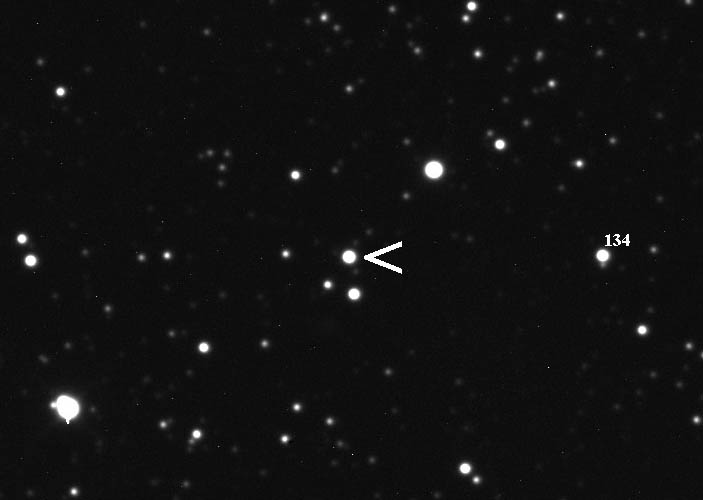Dwarf Nova on:
[Wikipedia]
[Google]
[Amazon]
 A dwarf nova (pl. novae), or U Geminorum variable, is one of several types of cataclysmic variable star, consisting of a close
A dwarf nova (pl. novae), or U Geminorum variable, is one of several types of cataclysmic variable star, consisting of a close
 A dwarf nova (pl. novae), or U Geminorum variable, is one of several types of cataclysmic variable star, consisting of a close
A dwarf nova (pl. novae), or U Geminorum variable, is one of several types of cataclysmic variable star, consisting of a close binary star
A binary star or binary star system is a system of two stars that are gravitationally bound to and in orbit around each other. Binary stars in the night sky that are seen as a single object to the naked eye are often resolved as separate stars us ...
system in which one of the components is a white dwarf
A white dwarf is a Compact star, stellar core remnant composed mostly of electron-degenerate matter. A white dwarf is very density, dense: in an Earth sized volume, it packs a mass that is comparable to the Sun. No nuclear fusion takes place i ...
that accretes matter from its companion. Dwarf novae are dimmer and repeat more often than "classical" novae.
Overview
The first one to be observed was U Geminorum in 1855; however, the mechanism was not known until 1974, when Brian Warner showed that the nova is due to the increase of the luminosity of the accretion disk. They are similar to classical novae in that the white dwarf is involved in periodic outbursts, but the mechanisms are different. Classical novae result from the fusion and detonation of accreted hydrogen on the primary's surface. Current theory suggests that dwarf novae result from instability in the accretion disk, when gas in the disk reaches a criticaltemperature
Temperature is a physical quantity that quantitatively expresses the attribute of hotness or coldness. Temperature is measurement, measured with a thermometer. It reflects the average kinetic energy of the vibrating and colliding atoms making ...
that causes a change in viscosity
Viscosity is a measure of a fluid's rate-dependent drag (physics), resistance to a change in shape or to movement of its neighboring portions relative to one another. For liquids, it corresponds to the informal concept of ''thickness''; for e ...
, resulting in a temporary increase in mass flow through the disc, which heats the whole disc and hence increases its luminosity. The mass transfer from the donor star is less than this increased flow through the disc, so the disc will eventually drop back below the critical temperature and revert to a cooler, duller mode.
Dwarf novae are distinct from classical novae in other ways; their luminosity
Luminosity is an absolute measure of radiated electromagnetic radiation, electromagnetic energy per unit time, and is synonymous with the radiant power emitted by a light-emitting object. In astronomy, luminosity is the total amount of electroma ...
is lower, and they are typically recurrent on a scale from days to decades. The luminosity of the outburst increases with the recurrence interval as well as the orbital period; recent research with the Hubble Space Telescope
The Hubble Space Telescope (HST or Hubble) is a space telescope that was launched into low Earth orbit in 1990 and remains in operation. It was not the Orbiting Solar Observatory, first space telescope, but it is one of the largest and most ...
suggests that the latter relationship could make dwarf novae useful standard candles for measuring cosmic distances.
There are three subtypes of U Geminorum star (UG):
* SS Cygni
SS Cygni is a variable star in the northern constellation Cygnus (constellation), Cygnus (the Swan). It was discovered in 1896 by Louisa D. Wells, a computer working under Edward Charles Pickering, Edward Pickering at Harvard College Ob ...
stars (UGSS), which increase in brightness by 2–6 mag in V in 1–2 days, and return to their original brightnesses in several subsequent days.
* SU Ursae Majoris stars (UGSU), which have brighter and longer "supermaxima" outbursts, or "super-outbursts," in addition to normal outbursts. Varieties of SU Ursae Majoris star include ER Ursae Majoris stars and WZ Sagittae stars (UGWZ).
* Z Camelopardalis stars (UGZ), which temporarily "halt" at a particular brightness below their peak; a behavior termed a "standstill". They are interpreted as occupying the border between the classes of dwarf nova and the more stable nova-like variables.
In addition to the large outbursts, some dwarf novae show periodic brightening known as “ superhumps”. They are caused by deformations of the accretion disk when its rotation is in resonance with the orbital period of the binary.
References
External links
* * * * {{Authority control Astronomical events Binary stars